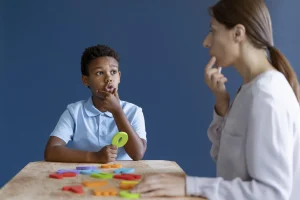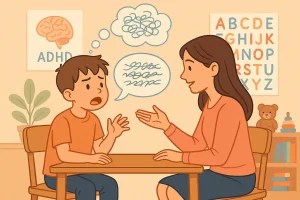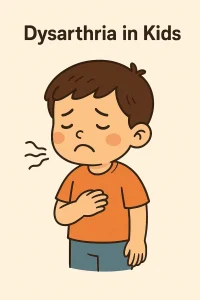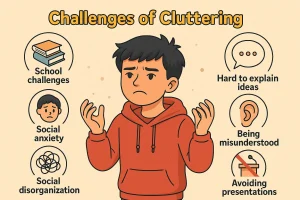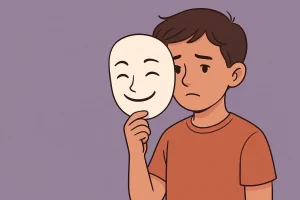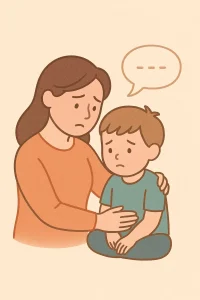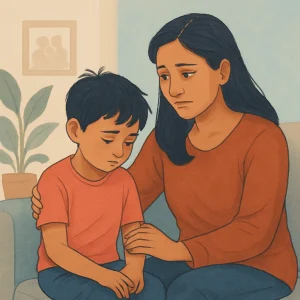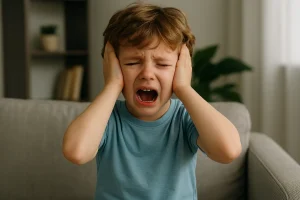10 Signs of Cluttering Speech Parents Shouldn’t Ignore
By Rajini D
Last Updated: March 12, 2025
Cluttering speech is a lesser-known speech disorder characterized by rapid, erratic speech patterns, making it hard for children to communicate clearly. Unlike stuttering, cluttering can lead to jumbled communication, affecting a child’s social interactions and confidence. Early detection and intervention are key. Recognizing signs early helps parents seek timely professional advice, enhancing their child’s speech clarity and overall communication skills. Stay tuned as we explore the top signs of cluttering speech, ensuring your child receives the support they need to thrive.
Book Your Online Free Speech Therapy Counselling Now
What is Cluttering?
Cluttering is a fluency disorder that impacts the flow and pace of speech, leading to rapid, erratic, or seemingly uncontrolled speech. This condition can make it challenging for children to express their thoughts clearly because their words can come out jumbled or too fast. Listeners often find it hard to keep up or understand the intent behind the words, which can lead to misunderstandings or frustration for both parties.
Also read: Cluttering Speech Explained: Causes, Symptoms and Help
How Cluttering Differs from Stuttering
| Feature | Cluttering | Stuttering |
|---|---|---|
| Speech Rate | Often rapid and irregular, which can make speech sound jerky or too swift. | Variable, often featuring interruptions in the normal flow of speech. |
| Awareness | Individuals may be unaware of their disfluency, not realizing their speech is unclear. | Typically aware of their disfluency, often experiencing anxiety about speaking. |
| Speech Patterns | Speech may include excessive filler words, pauses, or repetitions, but lacks the typical tension seen in stuttering. | Characterized by repetitions, prolongations, and blocks with noticeable physical tension. |
| Listener’s Understanding | Speech can be difficult to understand due to its disorganized or rapid nature. | Speech is interrupted by disfluencies, but the content may still be understood. |
| Self-Perception | May not recognize the need for correction unless feedback is given by others. | Often highly self-conscious about speaking and the reactions of others. |
Read More: Cluttering Speech Explained: Causes, Symptoms and Help
10 Signs of Cluttering Speech
Sign 1: Rapid and Irregular Speech Patterns
Children with cluttering often exhibit speech that is unusually fast and irregular. For example, a child may rush through a sentence so quickly that “Can I have some water?” sounds more like “C’nI’vesomewater?” This rapid pace can make their speech difficult to follow, as words may be slurred or condensed.
Example: A child says, “Wannagotothepark” instead of clearly articulating, “Want to go to the park?”
Sign 2: Excessive Fillers or Pauses
Excessive use of fillers like “um,” “like,” or “you know” can indicate cluttering. For instance, a sentence might be filled with unnecessary words: “I, um, just, you know, want, um, to go outside.” Similarly, abnormal pauses can occur not from searching for words, but rather from an erratic flow of thoughts, which disrupts their ability to speak smoothly.
Example: A sentence like, “I, um, just, like, think, um, it’s time to, you know, leave,” uses excessive fillers and pauses that disrupt the flow.
Sign 3: Repeated Syllables or Phrases
Repetition of sounds, syllables, or whole phrases is a common sign of cluttering. A child might repeat the start of a word multiple times, such as “bi-bi-bi-bicycle,” before finally saying the complete word.
Example: Repeating parts of words, such as saying, “Can-can-can I have some juice?” indicates a struggle to maintain fluent speech.
Sign 4: Disorganized Speech Structure
Children may exhibit disorganized or jumbled speech. They might start talking about one topic and suddenly jump to another without finishing the first, making it difficult for listeners to follow or understand the main point, such as saying, “Yesterday we went to—oh, can I have pizza for dinner?”
Example: A child starts telling a story about their day, “So I played with—oh and then we had lunch—but you know what? Look at this toy!” This shows a lack of organized thought flow.
Sign 5: Difficulty in Starting or Stopping Speech
Initiating or halting speech smoothly can be a challenge. For example, a child might abruptly start a conversation mid-thought, “—and then we went to the park,” leaving listeners confused as to the context of the conversation.
Example: Abruptly beginning or ending sentences, “—and then I saw a dog,” or “We went to the—so that’s what happened.”
Sign 6: Excessive Interjections
Frequent interjections disrupt the flow of speech. A conversation might be littered with excessive “uh,” “well,” “so,” which do not contribute to the narrative but rather serve to fragment their speech further, such as, “Well, I was, uh, thinking, so, maybe we could, uh, go to the zoo.”
Example: Overusing interjections within a short span, “Well, I mean, so, basically, the game was, like, really fun.”
Read more: Stuttering vs Cluttering: Understanding Speech Disfluencies
Sign 7: Poor Syntax and Grammar
Issues with forming correct and coherent sentences are prominent. A child might construct sentences backwards or in a mixed-up manner, like saying, “Yesterday, school I go didn’t,” instead of the correct form.
Example: Incorrect sentence structures, “Yesterday, movie I saw good was,” instead of, “The movie I saw yesterday was good.”
Sign 8: Inappropriate Pauses and Rhythms
Unusual pauses and rhythms can significantly affect speech clarity. A child might pause in the middle of a phrase or rush through important details, “We went to the… beach and then… we ate ice cream reallyfastanditwasgood.”
Example: Odd pauses in sentences, “We went to the—pause—store and bought—pause—some apples,” disrupting the natural rhythm.
Sign 9: Lack of Awareness of Listener’s Needs
A key issue is the child’s unawareness of the listener’s needs during communication. They may not notice when listeners look confused or need clarification, often continuing to speak without adjusting their speech or checking if the listener understands.
Example: Continuing to talk despite obvious confusion from the listener, without clarifying or adjusting their speech.
Sign 10: Speech Fatigue and Frustration
Cluttering can lead to frustration and speech fatigue in children. They might express irritation or tiredness after speaking, especially if they have been trying to explain something complex and feel they aren’t being understood, like saying, “Never mind, forget it! It’s too hard to tell you.”
Example: A child expresses frustration after a lengthy attempt to explain something, “It’s too hard to say it right, never mind!”
How Parents Can Help Children with Cluttering Speech
Supporting a child with cluttering speech involves proactive steps that encourage better communication habits and provide the necessary tools for improvement. Here are some practical tips for parents who wish to actively support their child’s communication development:
1. Create a Calm Speaking Environment
Foster a relaxed environment that encourages your child to speak without pressure. Avoid interrupting or finishing sentences for them, as this can create anxiety and make cluttering worse.
2. Practice Patient Listening
Show that you are listening attentively by giving them your full attention. This reinforces the importance of communication and encourages them to express themselves more clearly and confidently.
3. Simplify Language and Slow Down
Model slower speech patterns yourself. Use simple sentences and pause frequently, as this can help your child mirror these clearer speech habits.
4. Use Visual Aids
Incorporate visual aids like pictures or gestures that can help clarify spoken words and support better understanding.
5. Encourage Regular Practice
- Engage in regular practice sessions to help your child improve their speech pacing and clarity. Simple games involving turn-taking or storytelling can be beneficial.
6. Reinforce Efforts and Progress
- Acknowledge and praise improvements, no matter how small. Positive reinforcement can boost their confidence and motivation to keep working on their speech.
How Wellness Hub Supports Your Child’s Speech Development
At Wellness Hub, we specialize in identifying and managing speech disorders like cluttering through personalized, evidence-based therapy. Our expert speech-language pathologists work closely with each child to build communication clarity, confidence, and fluency. Using interactive techniques and parent-inclusive strategies, we focus on measurable progress tailored to your child’s pace. Whether you’re just noticing signs or already seeking support, our team is here to guide you every step of the way. Explore our online speech therapy services to start your child’s journey toward clearer, more confident communication—right from the comfort of your home.
Conclusion
Recognizing signs of cluttering speech like rapid talking and excessive pauses is crucial. As parents, your keen observation and response can make a real difference. Consulting with speech-language pathologists is vital for targeted help. At Wellness Hub, we offer resources and expert guidance to support your child’s communication journey. Get involved, use our tools, and see your child’s speech improve. Start today by visiting our Speech Therapy Resources for practical advice and support. Together, we can enhance your child’s confidence and communication skills. Early action leads to better outcomes!
Frequently Asked Questions:
1. What is cluttering speech in children?
Cluttering is a speech disorder characterized by a rapid and erratic speech rate, which makes it difficult for listeners to understand. Children with this disorder may speak in bursts or have unusually fast speech flow. This can lead to jumbled or incoherent speech that lacks typical rhythm and pacing.
2. How can I tell if my child has cluttering speech?
Key signs include speaking at a very fast pace, inserting excessive fillers like “um” or “ah,” repeating words or phrases, and having disorganized speech patterns. If your child’s speech seems rushed or scrambled and this pattern persists, it might be a sign of cluttering.
3. What causes cluttering speech?
The specific causes of cluttering are not entirely understood but it involves the brain’s processing and coordination for producing speech. Factors might include neurological development issues, genetic influences, or other communication disorder overlaps.
4. Is cluttering speech the same as stuttering?
No, cluttering and stuttering are distinct conditions. While stuttering primarily involves difficulties with starting speech sounds, syllables, or words, accompanied by noticeable tension, cluttering is marked by a rapid flow of speech that leads to reduced speech clarity and listener comprehension.
5. How does a speech therapist help a child with cluttering?
Speech therapists assess the specific challenges faced by the child and tailor interventions that may include techniques to slow down speech, improve articulation, and organize thoughts more effectively. Therapy might involve exercises to practice paced speaking and strategies to enhance linguistic organization.
6. Can cluttering speech be cured?
There is no cure for cluttering, but effective management is possible. Speech therapy can help children improve their ability to communicate clearly and effectively, thereby reducing the impact of cluttering on daily communication.
7. What are some simple activities to help my child at home?
Engaging in slow-paced reading sessions, using rhythmic tools like a metronome to pace speech, and practicing clear speech through fun activities like storytelling or singing can be helpful. These activities encourage the child to focus on the clarity and pace of their speech.
8. At what age should I seek help if I suspect my child has cluttering?
Early intervention is key, so it’s advisable to seek help as soon as you notice persistent signs of cluttering. Early childhood is a critical period for speech and language development, so the earlier the intervention, the better the outcomes.
9. How long does speech therapy take to improve cluttering speech?
Improvement timelines vary based on the severity of the disorder and the child’s response to therapy. Many children show noticeable improvement within several months of regular therapy, but ongoing support might be necessary to maintain and build on initial gains.
10. Where can I find resources for supporting my child with cluttering?
Wellness Hub offers a variety of speech therapy resources and expert guidance. Our platform provides tools, tips, and access to professional speech therapists who specialize in treating speech disorders like cluttering.
About the Author:
Rajini Darugupally
M.Sc., Speech-Language Pathologist (9+ years of experience)
Rajini is a passionate and dedicated Speech-Language Pathologist with over 9+ years of experience, specializing in both developmental speech and language disorders in children and rehabilitation in adults. Driven by a desire to empower each individual to find their voice, Rajini brings a wealth of experience and a warm, genuine approach to therapy. Currently, at Wellness Hub, she thrives in a team environment that values innovation, compassion, and achieving results for their clients.
Book your Free Consultation Today
Parent/Caregiver Info:
Client’s Details:
* Error Message

